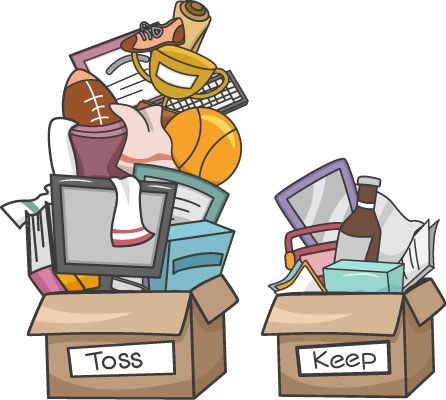Posted: January 7, 2015
Happy 2015! Why not start off this new year with a clean, uncluttered space? The wind is blowing and it’s cold outside, so now is a good time to dust off those shelves and reduce the collection of clutter from the last year.

Cluttered spaces can reduce efficiency and create an environment where children and adults feel stressed and overwhelmed with visual and informational overload. Plus, reducing clutter is an important step of integrated pest management (IPM). Boxes, piles of paper, and disorganized food and supply closets can provide what pests need to survive and thrive: food, water and shelter.
Cleaning around clutter is also very difficult. Lots of clutter and lack of adequate cleaning allow dust, dust mites, and other insect allergens to accumulate. This in turn reduces the indoor air quality in a building and may trigger an allergic reaction or asthma attack in some individuals.
But how and where do you begin tackling clutter? If there is a lot of clutter or many areas that need attention in the child care facility, start small, such as with a closet. To begin, make sure to have trash bags, tape and a marker handy. Make four piles and label them: keep, recycle, donate and throw away. Then:
- Go through all of the items in the space being de-cluttered and put each item into one of the four piles.
- Go back through the "keep" pile and make sure you want to keep those items.
- Clean the closet/area where the "keep" items will again be stored.
- Organize the "keep" items.
a. Place items in plastic containers with tight fitting lids. This will make it easier to clean and help to eliminate pest problems. Other types of storage furniture may need to be purchased depending on the area and the situation.
b. Label each container with its contents and where it goes within the space so everyone knows where to put it away.
c. All items, including storage containers, should be at least six inches off the floor for easier floor cleaning.
d. Put "keep" items away in their new location(s).
- Address the remaining bags of items.
a. Throw out the items in the "throw away" pile.
b. Recycle items in the "recycle" pile.
c. Donate items in the "donate" pile.
- Move on to another area in need. Follow the same steps.
General decluttering tips
- Donate, recycle or throw away items that haven't been used in the last two years.
- Break down and recycle empty cardboard boxes. Do not use cardboard boxes to store items.
- Hang brooms and mops up off the floor.
- Read and follow the label directions on all cleaning products (use green cleaning practices and products whenever possible).
- Store cleaning products and other chemicals in a locked cabinet out of reach of children.
Remember, decluttering and cleaning are ongoing processes. Children can get involved in the process as well. Taking the time to reduce clutter, clean, and get organized can improve the work and play environment for everyone in a facility. It also feels really good to walk into a space that is neat, clean and organized!
See the Pest Press newsletter for more information and ideas to help reduce clutter. For more information on preventing pests and keeping your home, school, or child care healthy and safe, visit the website of the Pennsylvania Integrated Pest Management Program. Like us on Facebook. Twitter users can follow us at handle @PAIPM.

